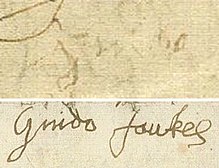401st Guy Fawkes celebrated in parts of the Commonwealth
Sunday, November 5, 2006

November 5, is Guy Fawkes Night. On this day, 401 years ago there was an attempt to blow up the British parliament.
Since that time, Guy Fawkes day is celebrated by bonfires, fireworks and the parading of effigies called "guys".

The event is not only celebrated in the United Kingdom, but other Commonwealth countries including New Zealand, South Africa, Newfoundland, Bahamas, Saint Kitts and formerly Australia.
Britons celebrate a national day of thanksgiving that the Gunpowder plot did not destroy their king and parliament. But as tradition goes, the oppression that Roman Catholics felt was always de-emphasised.
This year sees rising opposition to the traditional fireworks and bonfires celebrations. A smog warning has been issued for London on the 5th and British Labour MP Barry Sheerman called for the event to be scrapped.
The Gunpowder Plot
[edit]| Remember, remember, the 5th of November The Gunpowder Treason and plot; |
||
—Popular British rhyme in memory of the Gunpowder Plot | ||
The Gunpowder Plot of 1605 was a failed attempt by a few radical Roman Catholics to kill King James I of England, his family, and most of the Protestant aristocracy in a single attack by blowing up the Houses of Parliament during the State Opening. The conspirators had then planned to abduct the royal children, not present in Parliament, and incite a revolt in the Midlands.
The plot occurred during the long-running religious battle that followed King Henry VIII's break from Rome in 1534.
Far from helping their fellow Catholics avoid religious persecution, the plotters put many loyal Catholics in a difficult position. Before this period Catholicism had been associated with Spain and the Inquisition but after the plot it also became thought of as treasonous to be Catholic.

Fawkes was hired to do the "dirty work". He entered the Roman Catholic faith at the age of nine, when his mother married a Roman Catholic after the death of his father. As a soldier who went to war in the Netherlands, Fawkes was noted for bravery; he was one of the last to hear of the plot, and rushed into it before knowing the details.

The plot was actually planned by Robert Catesby, whose father had been imprisoned for refusing to convert to the Anglican Church. He started his planning two years previously in 1603. But he needed money and ammunition, which forced him to confide in at least 13 people. One of these was Francis Tresham, a brother-in-law of Lord Monteagle, and a member of the House of Lords
The plot failed when one of the conspirators warned his brother-in-law not to attend the House of Lords, who, in turn, set off the alarm that resulted in the ringleaders, including Guy Fawkes, being captured and executed.
Sources
[edit]- Reuters. "Smog warning ahead of bonfire night" — The Scotsman, November 5, 2006
- AAP. "UK Greens attack Guy Fawkes night" — NineMSN, November 5, 2006




